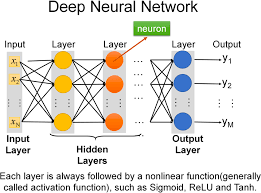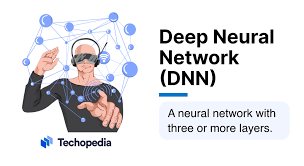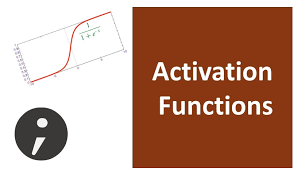Deep Neural Networks (DNN): A Comprehensive Guide 2024

Introduction
Deep Neural Networks (DNNs) are a powerful subset of artificial intelligence, enabling breakthroughs in image recognition, natural language processing, and autonomous systems. They are multi-layered artificial neural networks designed to process complex data patterns.
🚀 Why Learn Deep Neural Networks?
✔ Scalability: Handles vast amounts of data efficiently.
✔ Feature Learning: Automatically extracts meaningful patterns from data.
✔ High Accuracy: Powers cutting-edge AI applications.
✔ Real-World Applications: Used in self-driving cars, fraud detection, and medical imaging.
1. What is Deep Learning?

Deep Learning is a subset of machine learning that uses multi-layered neural networks to model and learn from data representations.
🔹 Key Characteristics of Deep Learning: ✔ Successive layers learn hierarchical representations.
✔ Requires large datasets for training.
✔ Backpropagation optimizes network parameters.
✔ Uses GPUs/TPUs for accelerated computations.
🚀 Example:
A speech recognition system processes raw audio through layers of convolutional and recurrent neural networks to understand spoken language.
✅ Why Deep Learning?
✔ Excels in processing unstructured data (images, text, audio).
✔ Learns complex patterns without manual feature engineering.
✔ Scales well with increasing data and computing power.
2. Architecture of Deep Neural Networks

A Deep Neural Network (DNN) consists of multiple layers of neurons structured into:
| Layer Type | Purpose |
|---|---|
| Input Layer | Receives raw data (e.g., pixel values of an image) |
| Hidden Layers | Extracts features and transforms inputs |
| Output Layer | Produces final predictions (classification, regression) |
Deep Feedforward Neural Networks
✔ Data flows in one direction (no loops).
✔ Each neuron applies weights, biases, and an activation function.
✔ Commonly used in image classification and tabular data prediction.
✅ Mathematical Representation:Z=W∗X+bA=f(Z)Z = W * X + b A = f(Z) Z=W∗X+bA=f(Z)
where:
- Z = Weighted sum
- W = Weights
- X = Input data
- b = Bias
- f(Z) = Activation function
3. Training a DNN Using Backpropagation

Backpropagation Steps:
1️⃣ Forward Propagation: Compute predictions based on input features.
2️⃣ Calculate Loss: Measure error using loss functions (e.g., cross-entropy, MSE).
3️⃣ Compute Gradients: Find how weights affect loss.
4️⃣ Update Weights: Use gradient descent to minimize loss.
📌 Loss Functions: ✔ Mean Squared Error (MSE): Used for regression.
✔ Cross-Entropy Loss: Used for classification.
🚀 Example: Image Recognition A DNN classifies handwritten digits (0-9) from the MNIST dataset.
✔ Forward propagation predicts the digit.
✔ Backpropagation adjusts weights to minimize misclassification.
✅ Key Insight:
More hidden layers = more abstraction, improving accuracy.
4. Activation Functions in DNNs

Why Use Activation Functions?
- Introduce non-linearity, enabling networks to learn complex functions.
- Help differentiate outputs, making backpropagation possible.
🔹 Common Activation Functions: ✔ ReLU (Rectified Linear Unit) – Most widely used, prevents vanishing gradients.
✔ Sigmoid – Squeezes output between 0 and 1, used for probabilities.
✔ Tanh – Zero-centered, better than Sigmoid in hidden layers.
✔ Softmax – Converts outputs into probability distributions (used in multi-class classification).
🚀 Example: Choosing the Right Activation Function ✔ Use ReLU for hidden layers to enable efficient training.
✔ Use Softmax for classification (e.g., identifying cat vs. dog images).
✅ Takeaway:
Activation functions decide whether a neuron should be activated or not.
5. Optimization Techniques for Deep Learning
Training deep networks efficiently requires choosing the right optimization algorithm.
🔹 Popular Optimization Algorithms: ✔ Gradient Descent (SGD) – Basic optimization method.
✔ Adam (Adaptive Moment Estimation) – Combines momentum with adaptive learning rates (most popular).
✔ RMSprop – Works well for recurrent networks.
✔ Adagrad – Adapts learning rate for each parameter dynamically.
🚀 Example: Improving Neural Network Training
- A DNN trained on financial fraud detection improves accuracy using Adam optimizer instead of standard SGD.
✅ Key Takeaway:
Choosing the right optimizer accelerates learning and prevents overfitting.
6. Convolutional Neural Networks (CNNs)
CNNs are specialized DNNs designed for image and video processing.
✔ Uses convolutional layers to extract spatial features.
✔ Works better than standard DNNs for image recognition.
✔ Uses pooling layers to reduce feature size.
🚀 Example: Face Recognition AI
✔ CNN detects facial features (eyes, nose, mouth).
✔ Uses deep layers to classify different faces.
✅ CNNs outperform regular DNNs for visual tasks.
7. Sequence Models & Recurrent Neural Networks (RNNs)
Unlike feedforward networks, RNNs process sequential data by remembering past inputs.
🔹 Why Use RNNs? ✔ Handles time-series, speech recognition, and language modeling.
✔ Uses memory cells to retain information over sequences.
🚀 Example: Predicting Stock Prices
- An RNN analyzes historical stock data to forecast future trends.
✅ Key Takeaway:
For time-dependent data, RNNs excel over standard DNNs.
8. Advanced Techniques: Attention Mechanisms & Transformers
Attention Mechanism
✔ Allows networks to focus on important parts of input sequences.
✔ Used in machine translation (Google Translate).
Transformers (e.g., BERT, GPT)
✔ Replaces RNNs in NLP tasks.
✔ Faster and more accurate for text processing.
🚀 Example: ChatGPT
✔ Uses Transformer architecture to generate human-like text.
✅ Key Takeaway:
Transformers revolutionized NLP, making chatbots more intelligent.
9. Neural Networks for Time Series Forecasting
Deep learning enables accurate time-series predictions.
✔ Uses LSTMs (Long Short-Term Memory networks).
✔ Works well for weather forecasting, stock market prediction, and demand forecasting.
🚀 Example: Predicting Future Sales Trends
✔ An LSTM model forecasts retail sales using past sales data.
✅ Deep Learning outperforms traditional statistical models in time series analysis.
10. Conclusion
Deep Neural Networks power modern AI applications, enabling breakthroughs in image processing, NLP, and time-series forecasting.
✅ Key Takeaways
✔ DNNs use multiple layers to extract deep data representations.
✔ Backpropagation & optimization techniques improve training efficiency.
✔ CNNs excel in computer vision, RNNs in sequential data.
✔ Transformers revolutionized NLP and AI-driven applications.
💡 How are you using Deep Neural Networks in your projects? Let’s discuss in the comments! 🚀
Would you like a hands-on tutorial on building a DNN using TensorFlow? 😊
4o